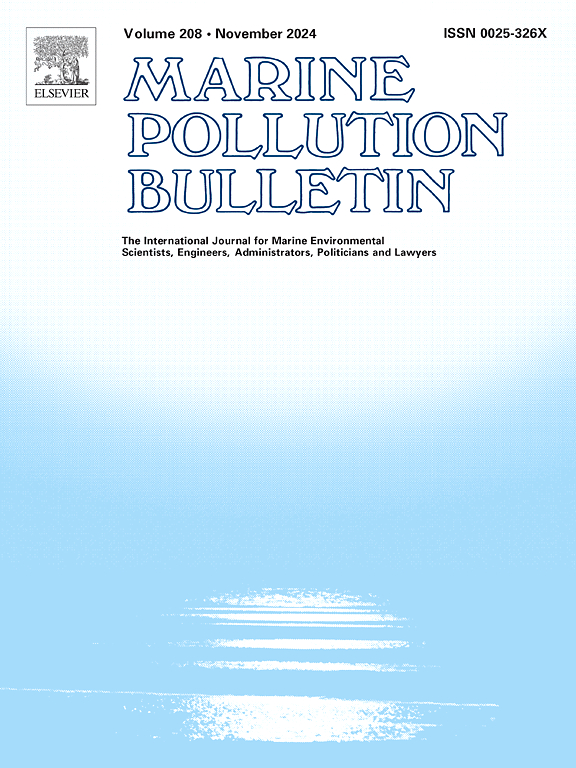A multi-compartment monitoring approach to assess the impact of marine litter in a Mediterranean coastal area
IF 5.3
3区 环境科学与生态学
Q1 ENVIRONMENTAL SCIENCES
引用次数: 0
Abstract
Marine litter, particularly microplastics, is a growing threat to the Mediterranean Sea, impacting biodiversity and ecosystem health. However, most studies conducted in the Mediterranean Sea have focused on monitoring of only specific environmental compartments, and rarely have highlighted the overall impacts affecting an area. Therefore, using a new multi-compartment monitoring approach and a standardized methodology, this study investigates the abundance, distribution, composition and impact of marine litter on beaches, surface waters, fish and mussels in a coastal area of Tuscany (Italy). Concerning beach macro litter values, significant differences were found among the three beaches analysed, with the highest amount in the Feniglia beach (mean value = 1245 items/100 m). The top items found are cotton bud sticks (32.3 %), which in the winter survey at Feniglia beach, reached a remarkable density of 1983 items/100 m. Microlitter (1–5 mm), was detected in the beach sediments with a mean abundance of 130 items/m2. Regarding floating macrolitter, the transect with the highest values was the Feniglia site at 3 nautical miles in autumn (1083 items/km2) while for floating microlitter the highest concentration (832,683 MPs/km2) was found in front of Scarlino. Of the 234 fish analysed from 5 different species, 67 contained microplastics in the gastrointestinal tract (28 %) with a mean value of 0.4 items per individual. The species with the highest occurrence was the European anchovy (Engraulis encrasicolus) (53 %) followed by the bogue (Boops boops) (40 %). Through the application of the Marine Litter Impact Index (MLII), considering all the compartments analysed, the Feniglia area emerges as the ecosystem most impacted by marine litter (mean MLII = 3.5, high). This study highlights how a multi-compartment monitoring approach is crucial for understanding the complex interactions between land, sea, and biota.
评估地中海沿岸地区海洋垃圾影响的多区监测方法。
海洋垃圾,特别是微塑料,对地中海构成日益严重的威胁,影响着生物多样性和生态系统健康。然而,在地中海进行的大多数研究只集中于监测特定的环境区域,很少强调影响一个地区的总体影响。因此,本研究采用一种新的多室监测方法和标准化方法,调查了意大利托斯卡纳沿海地区的海滩、地表水、鱼类和贻贝的海洋垃圾的丰度、分布、组成和影响。在海滩宏观凋落物值方面,三个海滩之间存在显著差异,其中芬尼利亚海滩的凋落物数量最多(平均值为1245件/100 m),棉芽棒密度最高(32.3%),在芬尼利亚海滩冬季调查中达到了1983件/100 m的显著密度。海滩沉积物中检测到微垃圾(1-5 mm),平均丰度为130个/m2。大凋落物浓度最高的样带为Feniglia站点,为1083个/km2;而微凋落物浓度最高的样带为Scarlino前,为832,683个/km2。在分析的来自5个不同物种的234条鱼中,67条(28%)的胃肠道中含有微塑料,平均每人0.4条。发生率最高的是欧洲凤尾鱼(Engraulis encrasicolus)(53%),其次是大灰鱼(Boops Boops)(40%)。通过应用海洋垃圾影响指数(MLII),综合分析所有区格,Feniglia地区是受海洋垃圾影响最大的生态系统(平均MLII = 3.5,较高)。这项研究强调了多区域监测方法对于理解陆地、海洋和生物群之间复杂的相互作用是至关重要的。
本文章由计算机程序翻译,如有差异,请以英文原文为准。
求助全文
约1分钟内获得全文
求助全文
来源期刊

Marine pollution bulletin
环境科学-海洋与淡水生物学
CiteScore
10.20
自引率
15.50%
发文量
1077
审稿时长
68 days
期刊介绍:
Marine Pollution Bulletin is concerned with the rational use of maritime and marine resources in estuaries, the seas and oceans, as well as with documenting marine pollution and introducing new forms of measurement and analysis. A wide range of topics are discussed as news, comment, reviews and research reports, not only on effluent disposal and pollution control, but also on the management, economic aspects and protection of the marine environment in general.
 求助内容:
求助内容: 应助结果提醒方式:
应助结果提醒方式:


